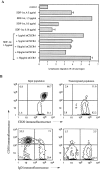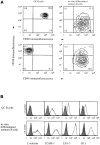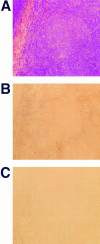B lymphocyte chemotaxis regulated in association with microanatomic localization, differentiation state, and B cell receptor engagement
- PMID: 9480985
- PMCID: PMC2212170
- DOI: 10.1084/jem.187.5.753
B lymphocyte chemotaxis regulated in association with microanatomic localization, differentiation state, and B cell receptor engagement
Abstract
Migration of mature B lymphocytes within secondary lymphoid organs and recirculation between these sites are thought to allow B cells to obtain T cell help, to undergo somatic hypermutation, to differentiate into effector cells, and to home to sites of antibody production. The mechanisms that direct migration of B lymphocytes are unknown, but there is evidence that G protein-coupled receptors, and possibly chemokine receptors, may be involved. Stromal cell- derived factor (SDF)-1alpha is a CXC chemokine previously characterized as an efficacious chemoattractant for T lymphocytes and monocytes in peripheral blood. Here we show with purified tonsillar B cells that SDF-1alpha also attracts naive and memory, but not germinal center (GC) B lymphocytes. Furthermore, GC B cells could be converted to respond to SDF-1alpha by in vitro differentiation into memory B lymphocytes. Conversely, the migratory response in naive and memory B cells was significantly reduced after B cell receptor engagement and CD40 signaling. The receptor for SDF-1, CXC chemokine receptor 4 (CXCR4), was found to be expressed on responsive as well as unresponsive B cell subsets, but was more rapidly downregulated on responsive cells by ligand. Finally, messenger RNA for SDF-1 was detected by in situ hybridization in a layer of cells surrounding the GC. These findings show that responsiveness to the chemoattractant SDF-1alpha is regulated during B lymphocyte activation, and correlates with positioning of B lymphocytes within a secondary lymphoid organ.
Figures










Similar articles
-
BCR ligation reprograms B cells for migration to the T zone and B-cell follicle sequentially.Blood. 2002 Mar 15;99(6):1913-21. doi: 10.1182/blood.v99.6.1913. Blood. 2002. PMID: 11877260
-
Coregulation of CXC chemokine receptor and CD4 expression on T lymphocytes during allogeneic activation.J Immunol. 2001 Apr 15;166(8):4870-8. doi: 10.4049/jimmunol.166.8.4870. J Immunol. 2001. PMID: 11290763
-
CXC chemokine receptor 4 expression and stromal cell-derived factor-1alpha-induced chemotaxis in CD4+ T lymphocytes are regulated by interleukin-4 and interleukin-10.Immunology. 2000 Mar;99(3):402-10. doi: 10.1046/j.1365-2567.2000.00954.x. Immunology. 2000. PMID: 10712670 Free PMC article.
-
Chemokines: role in inflammation and immune surveillance.Ann Rheum Dis. 2004 Nov;63 Suppl 2(Suppl 2):ii84-ii89. doi: 10.1136/ard.2004.028316. Ann Rheum Dis. 2004. PMID: 15479880 Free PMC article. Review.
-
Beyond migration-Chemokines in lymphocyte priming, differentiation, and modulating effector functions.J Leukoc Biol. 2018 Aug;104(2):301-312. doi: 10.1002/JLB.2MR1217-494R. Epub 2018 Apr 18. J Leukoc Biol. 2018. PMID: 29668063 Review.
Cited by
-
The anti-CD74 humanized monoclonal antibody, milatuzumab, which targets the invariant chain of MHC II complexes, alters B-cell proliferation, migration, and adhesion molecule expression.Arthritis Res Ther. 2012 Mar 9;14(2):R54. doi: 10.1186/ar3767. Arthritis Res Ther. 2012. PMID: 22404985 Free PMC article.
-
Epstein-Barr virus infection negatively impacts the CXCR4-dependent migration of tonsillar B cells.Immunology. 2006 Mar;117(3):379-85. doi: 10.1111/j.1365-2567.2005.02311.x. Immunology. 2006. PMID: 16476057 Free PMC article.
-
Invariant chain induces B cell maturation in a process that is independent of its chaperonic activity.Proc Natl Acad Sci U S A. 2002 Mar 5;99(5):3018-23. doi: 10.1073/pnas.052703299. Epub 2002 Feb 26. Proc Natl Acad Sci U S A. 2002. PMID: 11867743 Free PMC article.
-
Interplay between the heterotrimeric G-protein subunits Galphaq and Galphai2 sets the threshold for chemotaxis and TCR activation.BMC Immunol. 2009 May 8;10:27. doi: 10.1186/1471-2172-10-27. BMC Immunol. 2009. PMID: 19426503 Free PMC article.
-
B cell antigen receptor engagement inhibits stromal cell-derived factor (SDF)-1alpha chemotaxis and promotes protein kinase C (PKC)-induced internalization of CXCR4.J Exp Med. 1999 May 3;189(9):1461-6. doi: 10.1084/jem.189.9.1461. J Exp Med. 1999. PMID: 10224286 Free PMC article.
References
-
- Nieuwenhuis P, Ford WL. Comparative migration of B- and T-lymphocytes in the rat spleen and lymph-nodes. Cell Immunol. 1976;23:254–267. - PubMed
-
- MacLennan ICM. Germinal centers. Annu Rev Immunol. 1994;12:117–139. - PubMed
-
- Rajewsky K. Clonal selection and learning in the antibody system. Nature. 1996;381:751–758. - PubMed
-
- Kelsoe G. Life and death in germinal centers (Redux) Immunity. 1996;4:107–111. - PubMed
Publication types
MeSH terms
Substances
Grants and funding
LinkOut - more resources
Full Text Sources
Other Literature Sources
Research Materials
Miscellaneous

